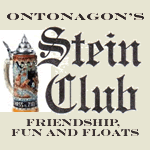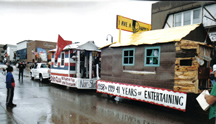
1999 Marriage of a Milennium
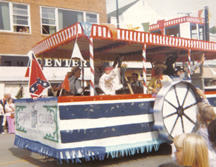
1972 Showboat

Yooperstein Olympics
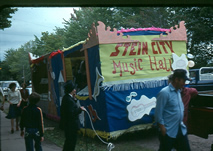
1979 Stein City Music

1971 Holidays On Wheels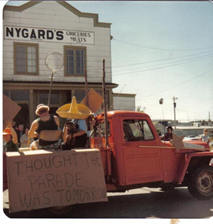 1978 We Forgot
1978 We Forgot
Parade Floats
Hank for President | Patriotism is No Hee Haw | Bostein Tea Party |Ex-Stein Terrestrial Pest
The Labor Festival . In the first ten to twenty years of its existence, the Ontonagon Labor festival evolved into a major annual event, boasting elaborate Miss Ontonagon County Queen Pageants, pony rides, horse pulling, drum corps competitions, water ski exhibitions, fireworks, football games, flea markets, antique car and tractor shows, horse shoe tournaments, talent shows, boat parades down the river, community chorus performances, Finnish and Yugoslav dancers, 5K runs, live fish grabs, two hour long parades and kiddie parades. In September, 1960, a reflection in the town's local newspaper, the Ontonagon Herald, exemplifies the grand scale of this rural civic celebration, “Jet planes from Kinross Air Force base flew over the main street and a cannon blast and fire siren signaled the start of the parade”. Depending on the weather, 5,000 to 10,000 people attended the festival throughout the 1960s and early 1970s. One crowd member voiced his enthusiasm for the event to a newspaper reporter, “If I couldn't get away from home any other time of the year, I'd wait until Labor Day and go to Ontonagon for their parade” ( 1961, Sept 7, 80/32). The Herald praised the festival calling it “an example of civic cooperation and improvement”(1964, Sept 10 83/33), “one of the largest festivals in Upper Michigan” and claimed that “the Ontonagon festival has no comparisons in the area” (1971, Sept 9, 90/34).
The Club's Floats . Initially, Jerry Hoefferle instigated the Stein Club's involvement in the Labor Festival. In 1957, Jerry and Ed Hanson, two prominent businessmen, chaired a committee of local merchants to plan the first festival in Ontonagon as an act of gratitude for the patronage of the community members. Labor Day weekend seemed to be the best time of the year to host a festival since the neighboring town of Bessemer already hosted a Fourth of July celebration, and nearby Bruce Crossing hosted the Log Jamboree in September. Mick Hoefferle adds, “(Ontonagon) was a very labor intensive town. The mine was just starting up, the lumber camps were still going, the mill was running hot and heavy. Very labor intensive then. All the money that made the businesses float came out of labor, thus the Labor Day celebration. The celebration was for the people.”
Jerry, being very proactive, called on his fellow members of the Stein Club to help get the celebration off the ground by entering the float competition in the Labor Festival parade. The Norwich Country Club, another men's organization similar to the Stein Club, also agreed to enter a float in the parade, and thus the fifty year friendly float rivalry between the two clubs began (link to info and photos). Statements like “Word has leaked out that the Stein Club and the Stein Club Women's Auxillary and the Norwich Country Club are all working on floats and will be fighting for first prize,” (1963, Aug 29 82/31) and “Float competition is always keen and the results outstanding. Rivalry between Stein Club and Norwich Country Club extends over a period of years with both groups having its share of winning entries” appeared in the local newspaper publicizing and heightening the contest between them (1977 96/34).
Mick Hoefferle describes the timeline and the ideation process behind the Stein Club's float-making activities in the following interview excerpts:
“ The meeting before Labor Day we would discuss it (float building). Someone would make a motion that we should have a float. Then we'd get ideas. The ideas would come all year. This stuff was being brainstormed all the time. It was an every year event. It was a competition with the Country Club. Once you sit down and make up your mind, it was done. We'd always have a place to build it at Harry Blake's garage for his oil trucks. And we'd get at it. About ten days. Whoever was painting would bring their extra paint, scrap lumber. The ladies were always involved with the floats. Bode LaBine sewed all the costumes.”
Mick also stated that the guys “would start off with an idea, fool around with it, and it started to grow. With twenty four members taking it in all different directions, each person is adding his little twist. In the late 1960s, the wives of the Stein Club members entered their own floats, and even trumped the men for top prize two or three times. The women called themselves the “Stein Club Auxiliary,” and their float themes had their own distinct flavor and aesthetic sensibility. .
Most often all the Stein Club members, their wives and their children participated in float building as one cohesive group. With hay wagons for the foundation, the women and children tended to the detailed work of painting or applying the crepe paper to the wagon, and the men busied themselves with the larger construction. Some members donated old house paint, lumber or handmade costumes. Thick brown paper and/or cardboard from the local paper mill were standard materials used on every float that the club created.
Although the construction nights were family affairs, Shelia Hoefferle, Mick's wife, explained, “Very few of the floats actually had the children incorporated (during the parade) because of the drinking involved. We had almost two hours when we had to line up and wait for the judges to vote (which was when much of the imbibing took place). The Country Club and the Stein Club would have kegs of beer right on the floats!” Mick offered, “By the time we got down the street, we were well-oiled…”
The Club's float competed against other entries in the Labor Parade's Open Division (Junior and Commercial Divisions exist, as well). In the Open Division, any group, whether an organized non-profit or just an involved family group, may enter a float. Before the floats roll down the hill and through the observant crowds on Main Street, the judges would ensure that the floats complied with the parade rules (see rules) and evaluate them in three separate categories: Workmanship, Overall Appearance/ General Effects, and Special Effects (like costumes, music or moving parts). The most successful Club floats included rehearsed skits, music and lots of crowd appeal which elicited much “hootin and hollering” from observers.
From analysis of the twenty-three years of documented floats (photos of some floats were not available), a handful of loose themes emerge: Yooper interpretations of international or historic events, parodies of pop culture, political/patriotic, and straightforward crowd pleasers, with some float themes crossing into two or all four of the categories. Without a doubt, all the floats express local culture and a local aesthetic peculiar to this region of the United States. These uncategorized art forms are a means of communication, of dialogue between a local men's club with the wider American culture, its mass media, national politics, and current happenings.
